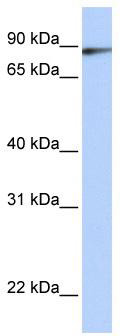ILF3 Rabbit Polyclonal Antibody
USD 200.00
USD 867.00
USD 665.00
Specifications
| Product Data | |
| Applications | WB |
| Recommended Dilution | WB |
| Reactivities | Human |
| Host | Rabbit |
| Isotype | IgG |
| Clonality | Polyclonal |
| Immunogen | The immunogen for anti-ILF3 antibody: synthetic peptide directed towards the C terminal of human ILF3. Synthetic peptide located within the following region: QQSYNQSPYSNYGPPQGKQKGYNHGQGSYSYSNSYNSPGGGGGSDYNYES |
| Formulation | Liquid. Purified antibody supplied in 1x PBS buffer with 0.09% (w/v) sodium azide and 2% sucrose. Note that this product is shipped as lyophilized powder to China customers. |
| Conjugation | Unconjugated |
| Storage | Store at -20°C as received. |
| Stability | Stable for 12 months from date of receipt. |
| Predicted Protein Size | 95 kDa |
| Gene Name | interleukin enhancer binding factor 3 |
| Database Link | |
| Background | ILF3 may facilitate double-stranded RNA-regulated gene expression at the level of post-transcription. ILF3 can act as a translation inhibitory protein which binds to coding sequences of acid beta-glucosidase (GCase) and other mRNAs and functions at the initiation phase of GCase mRNA translation, probably by inhibiting its binding to polysomes. ILF3 can regulate protein arginine N-methyltransferase 1 activity. ILF3 may regulate transcription of the IL2 gene during T-cell activation. It can promote the formation of stable DNA-dependent protein kinase holoenzyme complexes on DNA.Nuclear factor of activated T-cells (NFAT) is a transcription factor required for T-cell expression of interleukin 2. NFAT binds to a sequence in the IL2 enhancer known as the antigen receptor response element 2. In addition, NFAT can bind RNA and is an essential component for encapsidation and protein priming of hepatitis B viral polymerase. NFAT is a heterodimer of 45 kDa and 90 kDa proteins, the larger of which is the product of this gene. The encoded protein, which is primarily localized to ribosomes, probably regulates transcription at the level of mRNA elongation. Nuclear factor of activated T-cells (NFAT) is a transcription factor required for T-cell expression of interleukin 2. NFAT binds to a sequence in the IL2 enhancer known as the antigen receptor response element 2. In addition, NFAT can bind RNA and is an essential component for encapsidation and protein priming of hepatitis B viral polymerase. NFAT is a heterodimer of 45 kDa and 90 kDa proteins, the larger of which is the product of this gene. The encoded protein, which is primarily localized to ribosomes, probably regulates transcription at the level of mRNA elongation. At least three transcript variants encoding three different isoforms have been found for this gene. |
| Synonyms | CBTF; DRBF; DRBP76; MMP4; MPHOSPH4; MPP4; NF-AT-90; NF90; NF90a; NF90b; NF110; NF110b; NFAR; NFAR-1 |
| Note | Dog: 100%; Human: 100%; Pig: 93%; Horse: 93%; Bovine: 93%; Rat: 86%; Rabbit: 86%; Guinea pig: 86%; Mouse: 79% |
| Reference Data | |
| Protein Families | Druggable Genome, Transcription Factors |
Documents
| Product Manuals |
| FAQs |
| SDS |
{0} Product Review(s)
Be the first one to submit a review






























































































































































































































































 Germany
Germany
 Japan
Japan
 United Kingdom
United Kingdom
 China
China



